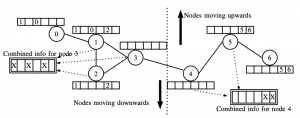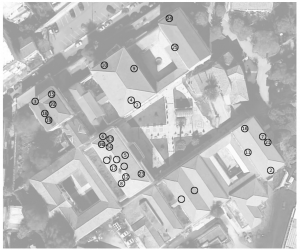The various research areas along with published papers are given in each submenu.
Some key areas involve the following:
Scalable facility placement in large-scale network environments

An example of a frame, consisting of three subframes, is depicted for each one of the nodes a, b and c, transmitting under all three policies. Each subframe consists of three slots (0-1-2 , 3-4-5 , 6-7-8 respectively). Slots marked with X are the ones assigned to each node by the Chlamtac-Farago algorithm. Slots marked with p are the slots during which each node may transmit under some probability. The slots during which the node is never allowed to transmit were left blank.

Coverage as a function of the forwarding probability q for various Geometric Random Graphs (GRG: rc = 0.3, 0.4, 0.5) and Erdos-Renyi (ER: p = 0.2, 0.3, 0.4) topologies. The particular values of 4/d , 4/λ1 , 1/d and 1/λ1 are also depicted. Apparently, for q>4/λ1 full coverage is a achieved Under probabilistic Flooding, while for q<1/λ1 coverage is negligible.
Spectrum Analysis
Energy Consumption
Cloud Gaming

An example of vehicles (Nodes) moving to opposite directions under VeMAC protocol. Nodes 3 and 4, moving towards opposite directions, become aware of occupied under VeMAC time slots by their two-hop neighbors and they randomly choose one of the non-occupied to transmit (and declare as occupied). The depicted time slots sets are different for each direction. Applying Time-Independent MAC policies may improve time delay and under certain conditions provide for guaranteed time constraints that are important for safety application in vehicular environments.






